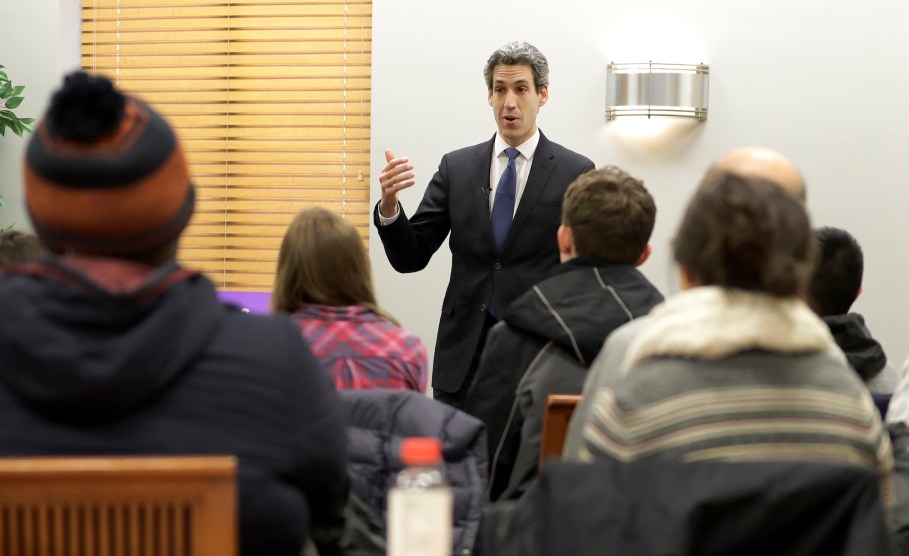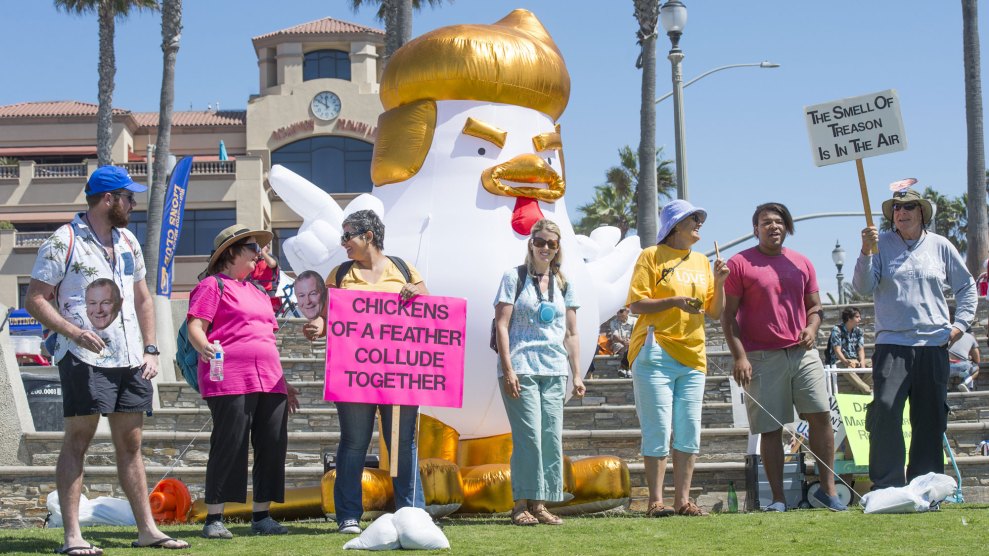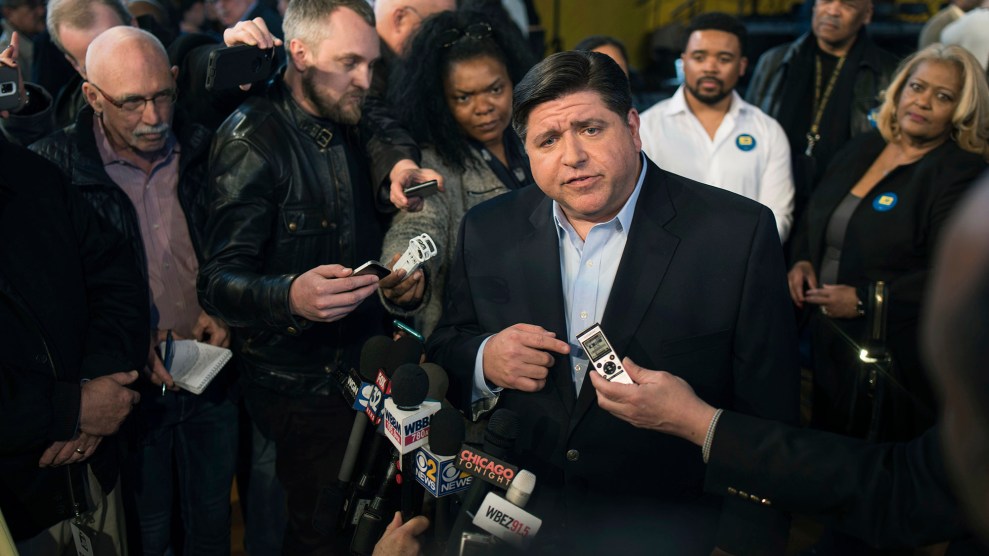
Daniel Biss, campaigning for governor of Illinois, addresses students at Elmhurst College in Elmhurst, Illinois.Charles Rex Arbogast/AP
On a mid-February morning, Illinois gubernatorial candidate Daniel Biss hit the road at 6:15 to begin an 18-hour day of driving. The 40-year-old Democratic state senator was on the last leg of his “Road Forward College Tour,” an eight-day trip to 14 of the state’s college campuses, and the final push was ambitious. He began the day in Champaign, home to the University of Illinois’ flagship campus, and traveled 140 miles to Western Illinois University, a smaller public college near the Iowa and Missouri borders. After hosting a town hall, he drove another 250 miles down to Southern Illinois University, where he spent the evening with students before making it back to his home in Chicago’s northern suburbs at midnight.
College tours are typical campaign fare, and Biss’ top rivals in the Democratic primary, businessmen J.B. Pritzker and Chris Kennedy, have done their share. But “college tour” understates what Biss has been doing since declaring his candidacy a year ago. The former University of Chicago math professor has visited 53 of the state’s colleges and universities, many more than once, to pitch a platform that seems designed to appeal to young voters, pledging free public college education and universal government-provided health care.
Biss is at the forefront of a national push by progressive—and often underdog—Democratic candidates to see if they can replay Bernie Sanders’ 2016 insurgency by getting young voters to turn out for them in 2018. Organizers across the country will look to Biss’ performance in next Tuesday’s primary—just the second contest in the 2018 midterm election season—to see whether a direct appeal to the youth vote and the support of millennial-driven progressive organizations can be stronger assets than massive campaign spending and establishment backing. There are signs that the strategy has boosted Biss, who moved from a distant third place to within 10 points of frontrunner Pritzker in two February polls. (The most recent poll, released on Monday, showed Pritzker opening a 19-point lead.)
The Prairie State is a reliable Democrat stronghold that hasn’t cast its electoral votes for a GOP president since George H. W. Bush. The incumbent governor, Bruce Rauner, is a Republican, but he’s currently even less popular than President Donald Trump in the state, according to one recent poll. That means the winner of the Democratic primary will likely be the favorite in the general election in what’s expected to be a big year for the party.
That winner wasn’t expected to be Biss. When he entered the governor’s race a year ago, few Illinoians knew his name; an early campaign volunteer recalls receiving blank stares when she mentioned Biss to attendees of Chicago’s March for Science in April 2017. Recognition came more easily to Pritzker, a billionaire whose family fortune has funded the state’s concert venues, charities, and top law and medical schools, and Kennedy, son of former Attorney General Robert F. Kennedy. In October, Biss had just 6 percent support in a We Ask America poll that put Pritzker at 39 percent and Kennedy at 15. But as Biss criss-crossed the state, his numbers crept up: At the end of January, that same poll placed him 12 points behind Pritzker and ahead of Kennedy, while two polls in February had him within 4 and 10 points, even as Pritzker has outspent him 17-1.
It’s a remarkably strong improvement for Biss, a product of academia whose biography hardly foretells a political rise. The son of two college professors, he grew up in Bloomington, Indiana, home to Indiana University, before heading to Cambridge, Massachusetts, where he received undergraduate and doctoral degrees in math from Harvard and MIT, respectively. He taught math for several years at the University of Chicago and then moved to Evanston, Illinois, home of Northwestern University, so his wife could pursue a Ph.D. in history.
“Nobody’s ever gone into academia, especially mathematics, and planned on using it as a springboard for politics,” he admits. But a lifetime spent in college towns acquainted Biss with the “constant activation and agitation around community issues.” So in 2004, when the young University of Chicago mathematician found himself outraged by photographs of abused Iraqi prisoners at Abu Ghraib, he was readily welcomed into Hyde Park’s community organizing fold. The work eventually consumed him, and he left his professorship in 2008 to run for office. He served as a legislator in the Illinois House of Representatives until 2012, when he won a seat in the state Senate. “It led me to start showing up to meetings, to start doing organizing work, to really fall in love with democracy,” he recalls of his early organizing days. “What could we do to actually make this mechanism of democracy reflect the public will?”
Though he set his scholarship aside a decade ago, speaking with Biss leaves me feeling like I’ve just emerged from a professor’s office hours. (Case in point: He began our conversation with an eager announcement that he was on his way to Mount Olive, Illinois, expecting me to know that was where this publication’s namesake, Mary Harris Jones, is buried. I’m sure I disappointed him when I failed to match the depths of his trivial knowledge.) “He doesn’t talk like a regular politician,” says Hari Sevugan, a principal with 270 Strategies, a public engagement firm founded by alumni of Barack Obama’s presidential campaigns, who serves as a campaign strategist for Biss. “It’s not good for soundbites. It’s horrible for debates.” Will Guzzardi, a Democratic Illinois state representative from Chicago and friend of Biss, says, “The thing about Daniel is, he’s not cool. He’s a real dweeb.”
But for voters who connected with a charisma-deficient septuagenerian in the 2016 presidential primaries, that may not be such a bad thing. Biss doesn’t resist being compared to Sanders—in his parlance, “I find that analogy worth spending time with.” Indeed, Biss has advanced thanks in part to Sanders’ groundwork, securing the endorsement of the Illinois chapter of Our Revolution, the progressive political action organization that spun out of Sanders’ presidential bid, at the end of January, and the national organization late last month. (Sanders himself has not endorsed a candidate in the race.) A range of liberal groups, like MoveOn.org and local Indivisible chapters, followed suit, tapping into their mailing lists and volunteer networks to build support for Biss. National progressive organizations are looking to the Illinois primary to learn how much firepower is left in Sanders’ progressive insurgency tank ahead of the November midterms.
“It’s a big state, and a big race,” says Larry Cohen, the chairman of Our Revolution. “We need candidates like this to make it a real race, not a marginal one.”
Securing the Democratic nomination for Illinois governor has historically required following a playbook that harkens back the Chicago political machine. In the state that midwifed the Progressive era, that’s meant mobilizing powerful labor institutions, courting influential Democratic endorsements, and currying favor with the state’s Democratic Party and its helmsman, Michael Madigan, the state party chair who has been speaker of the Illinois House of Representatives for all but two years since 1983. And, of course, it’s meant raising a lot of money. (The 2014 governor’s race set a state campaign spending record of $112 million, including $28 million of Rauner’s own money that he poured into the contest.)
By those measures, Pritzker would have the nomination in the bag. He’s received endorsements from more than 30 labor unions, including the powerful Illinois AFL-CIO, the Illinois Nurses Association, and the Illinois Federation of Teachers, and from Sens. Tammy Duckworth and Dick Durbin. Madigan intends to remain neutral in the primary, but Pritzker received a nod from the Illinois Democratic County Chairmen Association, a group with close ties to Madigan. And, as heir to the Hyatt Hotel fortune and one of the wealthiest men in the world, money is no object: Pritzker has already topped the $57.2 million the multimillionaire Rauner has invested in his own reelection campaign, spending $63.2 million of his own money and setting this up to be the most expensive governor’s race in history.
But 2018 is not shaping up to be a typical election year, opening the door for a candidate with a different sort of profile. In special elections around the country, Sevugan notes, “surge” voters—sporadic and new voters who were motivated to turn out to the polls by their distaste for Trump—have helped Democrats vastly outperform their 2016 showings. “These new voters are more energized, more progressive,” Sevugan says, noting that they’re seeking candidates who aren’t “part of the traditional power structure.” He adds, “We think Daniel can uniquely appeal to those people.”
Biss can’t match Pritzker’s union support, but Clem Balanoff, the chair of Our Revolution Illinois who ran Sanders’ 2016 campaign in the state, says progressive organizations offer an alternative—one composed primarily of young, passionate volunteers. “Unions have people to knock on doors, make phone calls, and they put money into direct mailers,” Balanoff explains. “But there’s something about the organic quality of grassroots support. A lot of times, there’s a deeper level of investment.”
Biss’ core message resembles a stripped-down version of Sanders’ platform, focused on four pillars: universal health care, free public college education, a progressive tax structure, and government reform through initiatives like public funding to match small campaign donations. (Young voters have also gravitated to his proposal to legalize marijuana, earning him the portmanteau “Cannabiss.”) College students and other millennials may also find it easier to relate to Biss himself—whose average household income has hovered around $55,000 over the past five years, according to his tax returns, and whose wife just finished paying off her student loans—than to Pritzker or Kennedy.
Illinois’ students have borne the brunt of a two-and-a-half year budget crisis that forced publicly funded schools to slash programs and temporarily stopped payments on grants for low-income college students. Illinois’ state university system has the fifth-highest tuition in the country, and in 2017, the state sent more freshmen to out-of-state colleges than any other. In a nationwide poll conducted during the 2016 election by Young Invincibles, a nonprofit that encourages civic engagement across young Americans, 61 percent of millennials—and three out of four black and Latino millennials—said candidates’ policies on student debt would be a major factor in how they would vote.
Young voters are a notoriously fickle bloc: They often don’t turn out in large numbers or donate to campaigns, and those from outside Illinois may have kept their registration in places where the presidential voting outcome wasn’t a foregone conclusion. But Erin Steva, the Midwest director for Young Invincibles, says that’s partly because campaigns have rarely focused their message on these voters. “What’s neat about the midterm elections is that we’re seeing campaigns speaking about college affordability and the need for reform in our higher education system,” she says. A recent Pew study found rising interest among younger voters in the year’s midterm elections: 62 percent say they are “looking forward” to the midterms, compared with 46 percent in 2014 and 39 percent in 2010 . And when they’re motivated, they can be remarkably unified behind a candidate. Sanders won nearly 90 percent of the primary vote in the University of Illinois at Urbana-Champaign precinct—with a roughly 4,100 percent increase in turnout over the 2012 Democratic presidential primary.
Of course, Biss isn’t alone in his appeal to young voters. Pritzker has urged greater investment in the state’s public colleges, apprenticeship and entrepreneurship opportunities for students, progressive tax reform, and legalizing marijuana. He has visited more than 30 colleges in the state.
Pritzker’s campaign rejects the characterization of Biss as the progressive candidate. In fact, Biss does push slightly farther left than Pritzker on a few issues: Biss wants single-payer health care, while Pritzker supports a public option, and Biss wants free public college for all students, while Pritzker supports exploring free college options for low-income students. But Biss still got into trouble with progressives in September when he dropped his original running mate, Chicago alderman and Democratic Socialists of America member Carlos Ramirez-Rosa, for supporting a boycott of Israel. Meanwhile, the Pritzker campaign reminds voters that Biss voted in favor of legislation that would cut pensions for state workers—something Biss has since apologized for—and garnish wages to pay back certain higher education loans.
Biss still has a lot of ground to cover in the primary campaign’s final week. A recent survey found he had the support of just 3 percent of African American Democrats, a key voting bloc Sanders also struggled with in 2016. Pritzker’s substantial fundraising advantage has enabled an advertising blitz with which Biss can’t really compete. Just this week, Pritzker released eight new radio ads featuring prominent Illinois Democrats who have endorsed him. (Not to be outdone, Kennedy ran a television ad narrated by Martin Sheen, who played Josiah Bartlet, the beloved fictional liberal president, on The West Wing.) Democrats are focused on defeating Rauner, and some may support Pritzker because they think he’s in a better financial position to do so. As for those college kids, the primary is in the middle of many schools’ spring breaks, with limited opportunities for early voting.
But Biss and his supporters remain optimistic. The latest polling finds more than 30 percent of Illinois voters undecided, leaving room for Biss to gain ground. Guzzardi, Biss’ statehouse colleague, says that no matter who comes out on top, the race will signal the way forward for Democrats. “This governor’s race is a perfect referendum on where the Democratic Party is,” he says. “In this era of Trumpism, how are Democrats going to respond? Are we going to respond by trying to beat them at their own game with our own billionaire candidate?”
He adds, “I think we’re going to send a really powerful message when Daniel wins the race he wasn’t supposed to win.”














